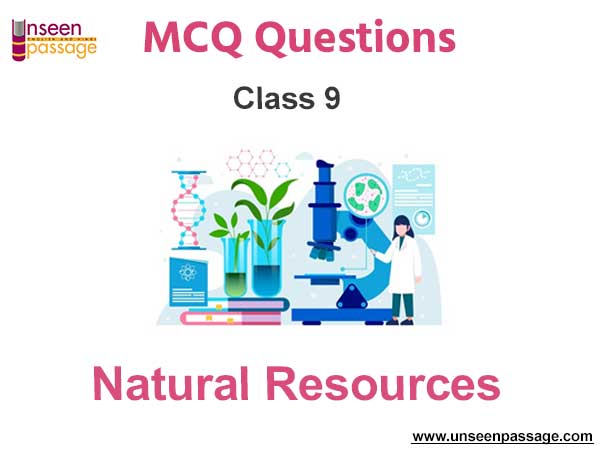Natural Resources MCQ Class 9 Science
Please refer to Chapter 14 Natural Resources MCQ Class 9 Science with answers below. These multiple-choice questions have been prepared based on the latest NCERT book for Class 9 Science. Students should refer to MCQ Questions for Class 9 Science with Answers to score more marks in Grade 9 Science exams. Students should read the chapter Natural Resources and then attempt the following objective questions.
MCQ Questions Class 9 Science Chapter 14 Natural Resources
The Natural Resources MCQ Class 9 Science provided below covers all important topics given in this chapter. These MCQs will help you to properly prepare for exams.
Question. Ozone layer is formed in the presence of
a. ultraviolet rays
b. infrared rays
c. chlorofluorocarbon
d. none of these.
Answer
A
Question. A hole in the ozone layer have been discovered above
a. Australia
b. America
c. Antarctica
d. Africa
Answer
C
Question. Which of the following abiotic factors lead to soil formation?
a. Sun
b. Wind
c. Water
d. All of these
Answer
D
Question. Which of the following is not a step in oxygen cycle?
a. Condensation
b. Combustion
c. Respiration
d. Photosynthesis
Answer
A
Question. Which of the following process does not produce carbon dioxide?
a. Photosynthesis
b. Respiration
c. Combustion
d. Decomposition of dead plants
Answer
A
Question. Which of the following gases are main contributors to acid rain?
a. Carbon dioxide and carbon monoxide
b. Sulphur dioxide and carbon dioxide
c. Sulphur dioxide and carbon monoxide
d. Sulphur dioxide and oxides of nitrogen
Answer
D
Question. Which of the following gas is the major component of atmosphere on Venus and Mars?
a. Oxygen
b. Carbon dioxide
c. Sulphur dioxide
d. Nitrogen dioxide
Answer
B
Question. The process by which atmospheric nitrogen are replenished is
a. nitrification
b. nitrogen fixation
c. denitrification
d. ammonification.
Answer
C
Question. Smog contains
a. unburnt carbon particles
b. water vapour
c. sulphur dioxide
d. all of these.
Answer
D
Question. A water borne disease is
a. Tuberculosis
b. Pneumonia
c. Typhoid
d. Diabetes
Answer
C
Question. Eutrophication results in
a. depletion of nutrients from water
b. depletion of dissolved oxygen in water
c. depletion on minerals present in water
d. all of these.
Answer
B
Question. Water pollution is caused by
a. fertilizers dissolved in farm run off
b. industrial effluents
c. sewage
d. all of these.
Answer
D
Question. The role of Rhizobium bacteria in nitrogen cycle is
a. ammonification
b. nitrification
c. nitrogen fixation
d. denitrification.
Answer
C
Question. Which of the following living organisms help in soil formation?
a. Lichens
b. Mosses
c. Earthworm
d. Both (a) and (b)
Answer
D
Question. Increase in temperature of water can disturb aquatic animals as it affects
a. The availability of nutrients
b. The amount of dissolved oxygen
c. Breeding of aquatic animals
d. both (b) and (c).
Answer
D
Question. The life supporting zone of the earth is
a. biosphere
b. ecosystem
c. lithosphere
d. atmosphere.
Answer
A
Question. Biologically important compounds that contain both nitrogen and oxygen are
a. protein
b. nucleic acid
c. carbohydrate
d. both (a) and (b).
Answer
D
Question. Which one of the following is the pioneer organism in the soil formation?
a. Mosses
b. Ferns
c. Lichens
d. Algae
Answer
C
Question. The quality of soil is not decided by
a. the amount of humus
b. the number of microscopic organisms
c. average size of the particles
d. all of these.
Answer
C
Question. Which of the following elements is not present in nucleic acids?
a. Nitrogen
b. Carbon
c. Oxygen
d. Sulphur
Answer
D
Question. Which of the following is a denitrifying bacteria?
a. Pseudomonas
b. Azotobacter
c. Nitrobacter
d. Nitrosomonas
Answer
A
Question. Oxygen is toxic for
a. Rhizobium bacteria
b. Nitrosomonas
c. Nitrobacter
d. blue green algae.
Answer
A
Question. Which mineral produced from industrial wastes pollutes water?
a. Arsenic
b. Mercury
c. Cadmium
d. All of these
Answer
D
Question. Which of the following is not a greenhouse gas?
a. Water vapour
b. Methane
c. Sulphur dioxide
d. Carbon dioxide
Answer
C
Question. Which of the following is not a natural resource?
a. Water
b. Forest and wildlife
c. Soil
d. Plastics
Answer
D
Question. Soil erosion can be prevented by
a. deforestation
b. afforestation
c. strong wind
d. heavy rain.
Answer
B
Question. Extreme temperature on moon is due to lack of
a. water
b. atmosphere
c. living organisms
d. both (a) and (b).
Answer
B
Question. Carbon dioxide is fixed by
a. the process of photosynthesis
b. the use of carbonates in sea water to make shells
c. the process of respiration
d. both (a) and (b).
Answer
D
Question. Uneven heating of the earth leads to
a. rain
b. snowfall
c. wind
d. all of these.
Answer
C
Question. Water is essential for living organisms as
a. transport of metabolites in our body takes place in dissolved form
b. all cellular processes occur between substances dissolved in water
c. it absorbs heat from our body
d. both (a) and (b).
Answer
D

We hope you liked the above Natural Resources MCQ Class 9 Science. In case you have any questions please put them in the comments box below and our teachers will provide you a response.
